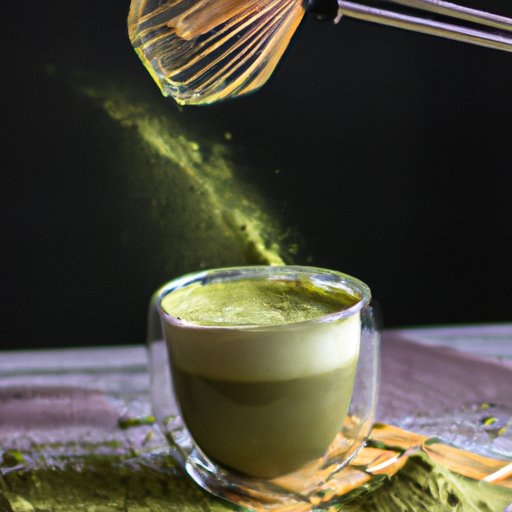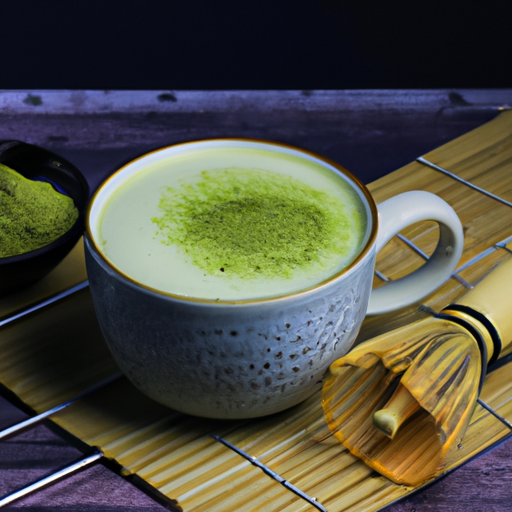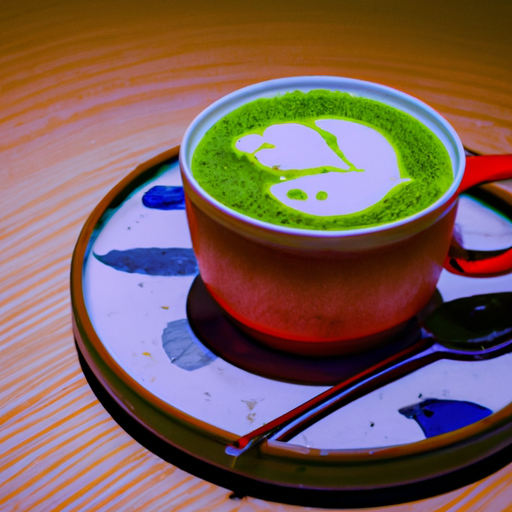As the well-known saying states, “You are what you drink.”
And if that’s true, then I want to be a matcha latte with almond milk. This vibrant green beverage is not only delicious but also packed with health benefits. Plus, it’s easy to make at home!
If you’re new to matcha or just looking for a healthy alternative to your morning coffee, this recipe is perfect for you. With just a few simple steps and ingredients, you can whip up a creamy and flavorful matcha latte in no time.
So grab your favorite mug and let’s get started!
Key Takeaways
- Matcha and almond milk together provide numerous health benefits, including antioxidants, vitamins, and minerals.
- Using high-quality matcha powder and natural sweeteners can enhance the flavor and health benefits of the latte.
- Almond milk is a great alternative to regular milk and is low in calories, cholesterol-free, and a good source of calcium and vitamin E.
- The process of making a matcha latte with almond milk involves whisking the matcha powder with hot water or almond milk to create a paste, adding sweeteners and foam for a creamy texture, and experimenting with alternative milks and spices to customize the flavor.
Gather Your Ingredients
Gatherin’ all your ingredients is the first step to makin’ a creamy and delicious matcha latte with almond milk. You’ll need some matcha powder, almond milk, honey or sweetener of your choice, and a whisk.
If you don’t have almond milk in hand, you can always use any other plant-based milk or even regular dairy milk as an ingredient substitution. However, keep in mind that using dairy milk may affect the health benefits of your drink.
Speaking of health benefits, did you know that matcha is packed with antioxidants? It’s also said to boost metabolism and improve brain function due to its caffeine content. Almond milk is another great addition as it’s low in calories and cholesterol-free. Plus, it contains vitamin E which acts as an antioxidant too.
By using these ingredients together, you’re creating a beverage that not only tastes good but also has some potential health benefits.
Now that we’ve gathered our ingredients let’s move on to heating up the almond milk!
Heat Your Almond Milk
First, warm up your preferred plant-based milk by placing it in a saucepan over medium heat and stirring constantly until it reaches the desired temperature. Heating almond milk has many benefits, including enhancing its taste and texture. The heat also helps break down the natural sugars in the milk, making it easier to digest.
There are different ways to heat almond milk, such as using a microwave or a frother, but I prefer using a saucepan for better control. To ensure that your almond milk doesn’t burn or scorch at the bottom of the saucepan, use a non-stick pan and stir continuously. You can also add other ingredients like vanilla extract or honey to enhance its flavor while heating.
Another way to heat almond milk is by using an electric frother that heats and froths simultaneously. This method saves time and gives you perfectly heated almond milk with creamy foam on top.
Once your almond milk reaches the desired temperature, remove it from the heat source and proceed to whisk your matcha powder. Whisking will help dissolve any lumps in the powder and create a smooth mixture for your latte.
Whisk Your Matcha Powder
Now that you’ve heated your plant-based milk to the desired temperature, it’s time to whisk your matcha powder into a smooth and creamy mixture. Matcha powder is not only delicious, but it also has many health benefits.
It contains antioxidants, vitamins, minerals, and caffeine that can boost metabolism and provide energy throughout the day. Before whisking your matcha powder, make sure to sift it through a fine mesh strainer to avoid clumps. Then, add a small amount of hot water or almond milk to create a paste-like consistency. This will help prevent lumps when mixing with the rest of the almond milk.
When whisking your matcha powder with almond milk, use a bamboo whisk or an electric frother for best results. Start by making fast circular motions at the bottom of the cup or bowl while gradually moving upwards until you reach a thick foam on top. Remember not to over-whisk as this may cause bitterness in taste.
Now that your matcha powder is perfectly whisked into a creamy mixture, it’s time to combine it with your heated almond milk for an indulgent and healthy treat!
Combine Your Matcha and Almond Milk
Once your matcha powder is perfectly whisked, it’s time to blend it with the silky smoothness of almond milk for a heavenly concoction that’ll knock your socks off! To ensure the best taste and quality, be sure to use high-quality matcha powder. The better the quality, the less bitter and more flavorful your latte will be.
If you’re not a fan of almond milk or have an allergy, there are plenty of alternatives to choose from. Oat milk, soy milk, coconut milk, and cashew milk are all great options that will still give you that creamy texture without overpowering the matcha flavor.
When combining your matcha powder and almond milk, start by heating up your desired amount of almond milk on the stove or in the microwave until it reaches a temperature you prefer. Then slowly pour in your whisked matcha powder while stirring constantly to avoid clumps.
Once fully combined, pour into a mug and enjoy!
Transition: Now that we’ve got our deliciously blended matcha latte ready to go, let’s add some sweetness (optional) for those who prefer their drinks a bit sweeter.
Add Sweetener (Optional)
To give your cozy and warm matcha drink a touch of sweetness, you can add your preferred sweetener like honey or agave syrup. There are various types of sweeteners that you can choose from, including natural ones like maple syrup or stevia. However, it’s essential to be mindful of the amount you use as adding too much can overpower the delicate taste of matcha and result in excessive calories.
When selecting a sweetener for your matcha latte with almond milk, it’s vital to consider its health effects. Some artificial sweeteners may cause digestive issues while others contain high levels of fructose that could lead to obesity and other health problems. Natural options such as honey and agave syrup have lower glycemic indexes compared to regular sugar, making them suitable for people managing their blood sugar levels.
Now that you’ve added your desired amount of sweetener into the mix, stir well until completely combined. If you prefer a frothy texture on top, proceed to the next step about topping with foam (optional).
Top with Foam (Optional)
If you’re looking to add a little extra flair to your cozy matcha drink, consider topping it with foam for an Instagram-worthy presentation. Foam not only adds a visually pleasing touch but also provides a creamy texture that enhances the drinking experience. Creating latte art on top of the foam is another way to impress your guests or simply elevate your at-home drinking routine.
To make foam for your matcha latte, you can use a frother or steam wand. An alternative method is shaking almond milk vigorously in a jar until it doubles in volume. The table below compares these methods:
| Method | Equipment Needed | Result |
|---|---|---|
| Frother/Steam Wand | Espresso machine with frothing wand or handheld electric frother | Smoother and denser foam that holds up better over time |
| Jar Shaking Method | A lidded glass jar or protein shaker bottle with room for milk expansion | Lighter and airier foam that dissipates faster |
It’s important to note that different alternative milks may produce varying results when it comes to creating foam. For example, oat milk tends to create thick and stable foam while soy milk produces larger bubbles and requires more effort to achieve ideal consistency.
Now that we’ve discussed how to top off your matcha latte with foam, let’s move on to experimenting with variations such as adding spices or swapping out almond milk for another dairy-free option.
Experiment with Variations
Get creative with your matcha drink by experimenting with different spices and alternative milk options to find your perfect combination. Matcha lattes are versatile drinks that can be customized to suit your flavor combinations and texture preferences.
If you’re looking for a spicy kick, add a dash of cinnamon or ginger to your matcha latte. Alternatively, if you prefer a sweeter taste, try adding honey or agave syrup.
Texture is also an important factor when it comes to creating the perfect matcha latte. Some people enjoy a thick and creamy texture, while others prefer a lighter consistency. Almond milk is an excellent alternative to regular dairy milk because it adds creaminess without being too heavy. However, you could also experiment with other milk options like coconut, oat or soy milk.
Once you’ve found the perfect flavor combination and texture preference for your matcha latte with almond milk, serve and enjoy! There’s nothing quite like sipping on a delicious hot beverage that’s been tailored to your specific tastes.
Whether you’re enjoying it in the morning as part of your daily routine or as an afternoon pick-me-up, this nutritious drink is sure to leave you feeling energized and satisfied.
Serve and Enjoy!
Now that you’ve experimented with different variations of your matcha latte, it’s time to serve and enjoy! Presentation is key when it comes to making a delicious drink. To make your latte look even more appealing, try garnishing it with some whipped cream or adding a sprinkle of cinnamon on top. Another option is to use a frother to create latte art designs on the surface of your drink.
As for flavor variations, there are endless possibilities when it comes to customizing your matcha latte with almond milk. You can add honey or agave syrup for sweetness and even experiment with different types of milk such as soy or oat milk. For an extra boost, try adding a scoop of protein powder or collagen peptides.
Remember that making a perfect matcha latte takes practice and patience, but the end result is worth it. So sit back, relax, and savor every sip of your homemade creation!
Moving forward, let’s talk about the benefits of combining matcha and almond milk in your diet.
Benefits of Matcha and Almond Milk
I love making matcha lattes with almond milk because not only does it taste delicious, but it also has numerous health benefits.
Matcha is packed with antioxidants and nutrients that help boost your immune system and protect against diseases.
Almond milk, on the other hand, is lower in calories and fat compared to regular dairy milk which makes it a great alternative for those who are watching their weight or have dietary restrictions.
Together, matcha and almond milk make a perfect combination that not only satisfies your taste buds but also nourishes your body from within.
Antioxidants and Nutrients
You’ll be pleased to know that by using almond milk in your matcha latte, you’re not only creating a delicious drink but also adding important antioxidants and nutrients to your diet.
Matcha is known for its high concentration of catechins, which are a type of antioxidant that helps protect the body against damage from free radicals.
Almond milk contains vitamin E, which is another powerful antioxidant that helps reduce inflammation in the body.
In addition to antioxidants, both matcha and almond milk are packed with other beneficial nutrients. Matcha is rich in vitamins A and C, as well as iron and potassium.
Almond milk is a good source of calcium and vitamin D, which are essential for strong bones and teeth.
Together, these two ingredients make for a nutritious and satisfying beverage that can help improve overall health. So let’s move on to how we can create this healthy drink that’s also lower in calories and fat!
Lower in Calories and Fat
Looking for a healthier alternative to your favorite coffee shop drink? Did you know that swapping out regular milk for almond milk in your matcha latte can significantly reduce the calories and fat content?
Almond milk is a great healthy alternative as it contains fewer calories and fat compared to regular milk. It also has no cholesterol or lactose, making it an excellent choice for people with dietary restrictions.
Not only does almond milk make your matcha latte healthier, but it also provides nutritional benefits. Almonds are rich in vitamin E, which helps protect cells from oxidative damage and supports healthy skin. It’s also packed with calcium, magnesium, potassium, and other essential nutrients that help maintain good health.
So next time you’re craving a matcha latte, consider using almond milk for a low-calorie and nutritious option!
Frequently Asked Questions
What is the best brand of matcha powder to use for a matcha latte?
When it comes to matcha powder brands for a matcha latte, taste preferences play a big role. Personally, I prefer using ceremonial grade matcha powder as it has a smooth and mellow flavor with a vibrant green color. Some popular brands that I’ve tried and enjoyed include Encha, Mizuba, and Jade Leaf.
However, there are also culinary grade matcha powders that may be more affordable and suitable for those who prefer a slightly bitter taste in their latte. Ultimately, it’s important to experiment with different brands until you find the one that meets your taste preferences.
Can I use a different type of milk instead of almond milk?
When it comes to making a matcha latte, there are a variety of milk alternatives that can be used instead of almond milk. Some popular options include soy milk, oat milk, coconut milk, and cow’s milk.
Each alternative has its own unique taste and nutritional profile, so it’s important to choose one that aligns with your personal preferences and dietary needs. For example, soy milk is a good choice for those who are looking for a high-protein option, while oat milk is known for being creamy and low in fat.
It’s also worth noting that different types of milk will produce slightly different results when it comes to the flavor and texture of your latte. So if you’re curious about trying something new, don’t be afraid to experiment!
How long can I store leftover matcha powder and almond milk?
When it comes to storing leftover matcha powder and almond milk, there are a few helpful tips to keep in mind.
First and foremost, it’s important to note the shelf life of each ingredient on its own. Matcha powder typically has a shelf life of around 6 months when stored properly in an airtight container away from light and moisture.
Almond milk, on the other hand, usually lasts around 7-10 days in the refrigerator after opening. When combining these ingredients for a matcha latte, it’s best to consume it within a day or two for optimal freshness.
However, if you do have leftovers, there are creative uses and recipes that can help prevent waste. For example, leftover matcha powder can be used as an ingredient in baked goods like cookies or muffins, while leftover almond milk can be added to smoothies or used as a dairy-free substitute in recipes calling for milk.
Just be sure to use your senses (smell and taste) before consuming any leftovers to ensure they haven’t gone bad.
Can I use a blender instead of a whisk to mix the matcha and almond milk?
When it comes to mixing matcha and almond milk, there are a few ways to go about it. One question that often comes up is whether a blender can be used instead of a whisk. While a whisk is the traditional tool for making matcha, a blender can work just as well – and may even produce a smoother, frothier result.
However, it’s important to note that not all blenders are created equal when it comes to matcha lattes. You’ll want to use one with enough power to create a strong vortex in the liquid, which will help incorporate air and create those coveted bubbles.
Additionally, if you’re looking for an alternative to almond milk or simply want an extra frothy latte, there are plenty of options out there – from oat milk and coconut cream to aquafaba (the liquid from canned chickpeas). As they say: there’s more than one way to skin a cat!
Are there any health risks associated with consuming too much matcha or almond milk?
Consuming too much matcha or almond milk can have potential health risks. Matcha contains high levels of caffeine, and excessive intake can lead to symptoms such as anxiety, insomnia, and heart palpitations. In rare cases, it may also cause liver damage.
On the other hand, almond milk allergies are more common than one might think. Those who are allergic to almonds may experience symptoms like hives, itching, wheezing, and anaphylaxis. It’s essential to be mindful of how much matcha you consume and ensure that you don’t exceed recommended daily limits.
Moreover, if you have a nut allergy or suspect that you might be allergic to almonds, avoid consuming almond milk altogether and opt for a different alternative instead.
Conclusion
So there you have it, folks! Making a matcha latte with almond milk is easy and delicious.
Not only is it a tasty treat, but it also has some amazing health benefits. Matcha powder is packed with antioxidants and can improve focus and concentration, while almond milk is low in calories and high in nutrients like vitamin E.
But beyond the health benefits, making a matcha latte with almond milk can be seen as a metaphor for life itself. Just like how we need to combine different ingredients to create something wonderful, we also need to mix different experiences and perspectives to create a fulfilling life.
And just like how adding sweetener or foam can enhance the taste of our lattes, adding kindness or creativity can enhance the quality of our lives.
So go ahead and make yourself a matcha latte with almond milk, savor every sip, and remember that sometimes the best things in life are made by combining seemingly disparate elements. Cheers!










